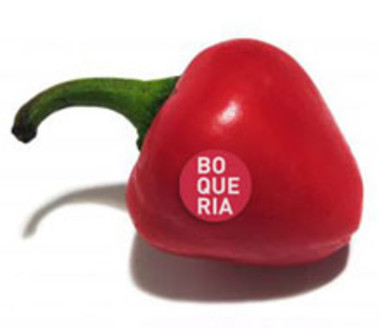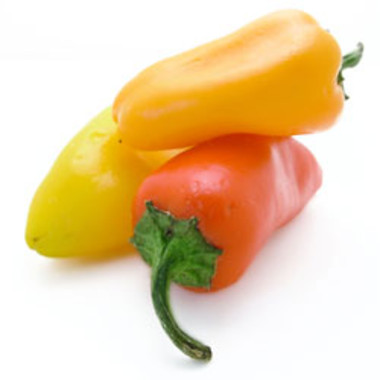La Boqueria Covers The Market
Brandchannel.com - March 20, 2006

You can hear the roar of the crowd as you approach. It’s not unlike the sound of walking through the tunnel and out into the stands at a ball game, complete with goose bumps.
Welcome to Barcelona’s most famous food market, La Boqueria. A covered market with hundreds of stalls devoted to nothing but food, it is arguably one of the most beautiful markets in the world and a place where even the city’s French neighbors could learn a few tricks.
Walking into the market is known to give even spaghetti-and-hamburger diehards an urge to push their culinary boundaries, and true foodies tend to lose themselves for hours. In the age of big box stores, where stores like Carrefour are a short metro ride away and many grocery stores dot the city center, the market not only persists, it thrives.
Despite the potential big-box threats, people here still refer to the market—technically known as the Mercat de Sant Josep, but nobody calls it by that name—as the heart and soul of the city and Catalan cooking. On Christmas Day, it even made the cover of the Catalan newspaper, La Vanguardia. Most importantly, people shop at the market like it may be their last meal.
Food professional Pep Palau has a bird’s eye view of it all. As the head of the Forum Gastronomic, which he describes as “the meeting place for food professionals,” not only does he see the market’s importance for chefs and home cooks, he has a greater sense of its gastronomic high place and how it stays there.
Like most successful enterprises, it’s not easy to define what exactly makes La Boqueria work. The key, says Palau, rests in the sum of its parts. “It’s a bunch of little things, but what they’ve done is something much bigger.â€
“It’s become a cult place in Spain’s new gastronomy,” he says. For the most part, he can’t say enough about the market’s success and understands its broad appeal. This is reflected in the clientele, which ranges from tourists who wander the aisles with cups of fresh-squeezed fruit juice to well-known chefs who stock up on the best produce to create a style of food known in Catalan as cuina de mercat.
As Palau gathers larger thoughts, he rattles off a stream of compliments.

“It’s authentic, it’s beautiful, it’s easy to get to, and it’s prestigious,” he explains. “If you talk to chefs, they talk about it.”
He also describes the market’s role as the heart of the city. “The market has become a space where if you go to Barcelona, you go there. People even prefer it to museums.”
It’s not all roses and superlative sound bites. Most notably, it can be expensive to shop there. “It has become something of a specialty store,” explains Palau. “The prices are the highest in Barcelona.”
This may be the cost of quality and variety. Depending on whom you speak with, the Boqueria holds between 20,000 and 40,000 different products under its roof, and is big enough to support vendors who sell nothing but items like bananas or eggs. There’s even a stand with edible bugs.
As part of the market’s dedicated staff, Boqueria manager Oscar Uribe is one of the keys to the market’s success.
“Usually the people who do my job in other markets aren’t in an office all day, they’re out on the floor selling fish,” he explains. This advantage allows Uribe and his team to build and keep momentum that a fishmonger needs to devote to selling, gutting, and filleting.
“My job is to do anything I can for the market—talk to the press, organize cooking classes, even help the vendors refurbish their stalls,” he explains.
In 2003, the Boqueria got a boost with the addition of cooking classroom space on the market grounds—something seemingly simple that turns out to be a strong selling and customer retention point for the entire market. “The cooking courses are a way for people to get to know the products,” says Uribe.
They’re definitely not offering courses to help pay for Uribe and his colleagues. Ask if the cooking courses actually make money and he scoffs. It’s clear, however, that the students are mostly local, they come to the courses often, talk about it with their friends, and they do their shopping downstairs when class is finished.
It’s not just a bunch of home cooks doing their shopping at the market, either.
“All of the top restaurants buy here,” he says—something that adds cachet among the non-professionals. It’s certainly no accident that three-star chef Ferran Adria keeps a laboratory in the city a stone’s throw from the market’s entrance. Get the word out that the best chefs in town shop at your market, and it’s a safe bet that sales will rise.
Though it seems to go against the grain of the mom-and-pop feeling of a market, the Boqueria even creates partnerships with producers as long as their products could be beneficial to the market. General Mills need not apply; the recent sponsors whose flags wave above the market stalls include a local beer called Moritz, along with pineapple, orange, and olive oil and even tripe producers.
Finally, Uribe stresses quality and diversity. He’s currently working on partnering with other European markets to allow a maximum number of products in the market, and while speaking with him, as if on cue, he gets a call from someone at London’s famous Borough Market to work on the project.
Down on the market floor, another key to success are the traditional kioskos, mini-restaurants crammed into market stalls which are ringed with stools. The kioskos are the birthplace of cuina de mercat, and their fare tends to be some of the freshest food you can get.
Pinotxo Bar is one of the best and most popular kioskos, with the spry Joan Bayén, 70, chatting up the ladies who walk by as he takes orders. Behind him, his nephews are at the center of a beehive of open-kitchen activity—two rough-shaven men in Asian-looking chef’s coats, who retain the air of a pair of hungover Jedis, manning a grill and a wok station.
Chef Jordi Asim describes how he and his brother grew up in the market, and it’s clear that the merchants who come by for a bite are treated like family. “First and most importantly, we’re here for the people who work in the market.” He’s not exaggerating. Joan opens Pinotxo at 6 a.m. so the market workers can get a good cup of Joe and a croissant before opening their stalls. All day, butchers and fishmongers get star treatment.
However, “regular†clients aren’t treated like second-class citizens. As Asim talks, a nearby client reels off a list of what he’s eaten to the waitress and each dish brings a smile to his face.
“People come [to the Boqueria] because it’s fresh and alive,” says Asim. “The restaurant is a bit of a show—they come and look and see all the food they can cook and their gastric juices get flowing.
“You have the option to buy elsewhere, but everyone still buys here.” For markets that compete with the controlled environment and convenience of the local supermarket, that’s no small achievement.
Joe Ray is a freelance writer living in Europe. He can be contacted via his website, www.joe-ray.com.